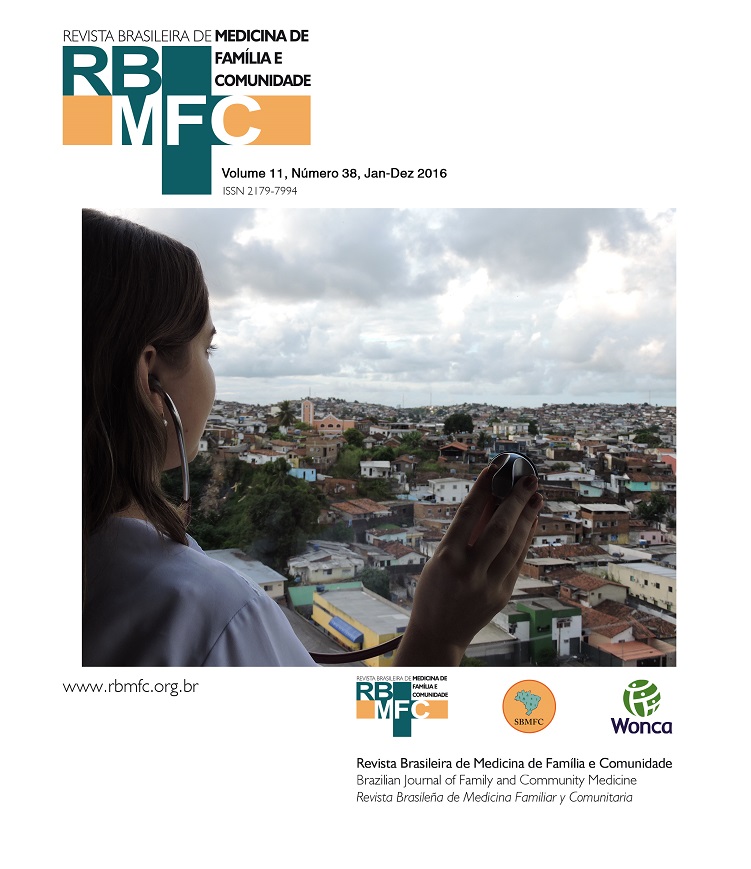La melatonina en insomnio primario: ¿ qué evidencias?
DOI:
https://doi.org/10.5712/rbmfc11(38)845Palabras clave:
Melatonina, Trastornos del Inicio y del Mantenimiento del Sueño, RevisiónResumen
Objetivos: revisar la evidencia existente sobre el uso de la melatonina en el alivio de los síntomas del insomnio primario y una mejor calidad de vida en pacientes ≥55 años de edad. Métodos: búsqueda en las bases de datos Pubmed y sitios de medicina basada en la evidencia de meta-análisis (MA), revisiones sistemáticas (RS), ensayos controlados aleatorizados (ECAC) y normas de orientación clínica (NOC), usando los términos MeSH Melatonin and Sleep Initiation and Maintenance Disorders, publicados entre marzo del 2007 y enero del 2013, en Inglés, Portugués y Español. Para la asignación de niveles de evidencia y fuerza de recomendación se utilizó la Strenght of Recommendation Taxonomy (SORT) de la American Family Physician. Resultados: se encontraron 72 artículos, los cuales se seleccionaron seis: cinco ECAC y una NOC. El ECAC concluye que la melatonina ha mejorado significativamente la calidad del sueño, el estado de alerta por la mañana y la calidad de vida en comparación con el placebo. Se observó una disminución significativa en la latencia del sueño. No hubo efectos de retirada tras la interrupción del tratamiento. La NOC recomienda que en pacientes >55 años de edad se prefiere utilizar melatonina en comparación con el uso de un hipnótico. Conclusión: existe evidencia suficiente para recomendar el uso de la melatonina en el alivio sintomático del insomnio primario (SOR A), y en la mejora de la calidad de vida (SOR B). Se necesitan más estudios, con metodologías rigurosas y seguimiento a largo plazo para obtener resultados más consistentes.
Descargas
Métricas
Citas
American Psychiatric Association. Diagnostic and statistical manual of mental disorders. 4th ed. Washington: American Psychiatric Press; 1994. p.866.
American Academy of Sleep Medicine. The International Classification of Sleep Disorders Steering Committee, Second Edition: Diagnostic and Coding Manual. Chicago: American Academy of Sleep Medicine; 2005.
Ohayon MM, Paiva T. Global sleep dissatisfaction for the assessment of insomnia severity in the general population of Portugal. Sleep Med. 2005;6(5):435-41. DOI: http://dx.doi.org/10.1016/j.sleep.2005.03.006 DOI: https://doi.org/10.1016/j.sleep.2005.03.006
Monti JM. Insônia primária: diagnóstico diferencial e tratamento. Rev Bras Psiquiatr. 2000;22(1):31-4. DOI: http://dx.doi.org/10.1590/S1516-44462000000100009 DOI: https://doi.org/10.1590/S1516-44462000000100009
Haimov I, Laudon M, Zisapel N, Souroujon M, Nof D, Shlitner A, et al. Sleep disorders and melatonin rhythms in elderly people. BMJ. 1994;309(6948):167. DOI: http://dx.doi.org/10.1136/bmj.309.6948.167 DOI: https://doi.org/10.1136/bmj.309.6948.167
Prontuário Terapêutico Online [Acesso 01 Mar 2013]. Disponível em http://www.infarmed.pt/prontuario/index.php
Ebell MH, Siwek J, Weiss BD, Woolf SH, Susman J, Ewigman B, et al. Strength of recommendation taxonomy (SORT): a patient-centered approach to grading evidence in the medical literature. J Am Board Fam Pract. 2004;17(1):59-67. PMID:15014055. DOI: http://dx.doi.org/10.3122/jabfm.17.1.59 DOI: https://doi.org/10.3122/jabfm.17.1.59
Lemoine P, Nir T, Laudon M, Zisapel N. Prolonged-release melatonin improves sleep quality and morning alertness in insomnia patients aged 55 years and older and has no withdrawal effects. J Sleep Res. 2007;16(4):372-80. http://dx.doi.org/10.1111/j.1365-2869.2007.00613.x. PMID:18036082 DOI: https://doi.org/10.1111/j.1365-2869.2007.00613.x
Wade AG, Ford I, Crawford G, McMahon AD, Nir T, Laudon M, et al. Efficacy of prolonged release melatonin in insomnia patients aged 55-80 years: quality of sleep and next-day alertness outcomes. Curr Med Res Opin. 2007;23(10):2597-605. PMID: 17875243. DOI: http://dx.doi.org/10.1185/030079907X233098 DOI: https://doi.org/10.1185/030079907X233098
Luthringer R, Muzet M, Zisapel N, Staner L. The effect of prolonged-release melatonin on sleep measures and psychomotor performance in elderly patients with insomnia. Int Clin Psychopharmacol.2009;24(5):239-49. PMID: 19584739. DOI: http://dx.doi.org/10.1097/YIC.0b013e32832e9b08 DOI: https://doi.org/10.1097/YIC.0b013e32832e9b08
Wade AG, Ford I, Crawford G, McConnachie A, Nir T, Laudon M, et al. Nightly treatment of primary insomnia with prolonged release melatonin for 6 months: a randomized placebo controlled trial on age and endogenous melatonin as predictors of efficacy and safety. BMC Med. 2010;8:51. PMID: 20712869. PMCID: PMC2933606 DOI:http://dx.doi.org/10.1186/1741-7015-8-51 DOI: https://doi.org/10.1186/1741-7015-8-51
Wade AG, Crawford G, Ford I, McConnachie A, Nir T, Laudon M, et al. Prolonged release melatonin in the treatment of primary insomnia: evaluation of the age cut-off for short- and long-term response. Curr Med Res Opin. 2011;27(1):87-98. PMID: 21091391. DOI: http://dx.doi.org/10.1185/03007995.2010.537317 DOI: https://doi.org/10.1185/03007995.2010.537317
Wilson SJ, Nutt DJ, Alford C, Argyropoulos SV, Baldwin DS, Bateson AN, et al. British Association for Psychopharmacology consensus statement on evidence-based treatment of insomnia, parasomnias and circadian rhythm disorders. J Psychopharmacol. 2010;24(11):1577-601. DOI: http://dx.doi.org/10.1177/0269881110379307 DOI: https://doi.org/10.1177/0269881110379307
NICE - National Institute for Healh and Care Excellence - Insomnia, last revised in July 2009 [Acesso 15 Ago 2015]. Disponível em: http://cks.nice.org.uk/insomnia
Ramakrishnan K, Scheid DC. Treatment options for insomnia. Am Fam Physician. 2007;76(4):517-26. PMID: 17853625
Buscemi N, Vandermeer B, Friesen C, Bialy L, Tubman M, Ospina M, et al. The efficacy and safety of drug treatments for chronic insomnia in adults: a meta-analysis of RCTs. J Gen Intern Med. 2007;22(9):1335-50. PMID: 17619935 PMCID: PMC2219774. DOI: http://dx.doi.org/10.1007/s11606-007-0251-z DOI: https://doi.org/10.1007/s11606-007-0251-z
Descargas
Publicado
Cómo citar
Número
Sección
Licencia
Al enviar un manuscrito al RBMFC, los autores conservan la propiedad de los derechos de autor del artículo y autorizan a RBMFC a publicar ese manuscrito bajo la licencia Creative Commons Attribution 4.0 e identificarse como el vehículo de su publicación original.















